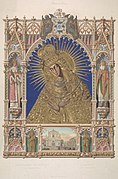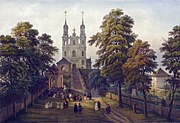Jan Kazimierz Wilczyński

Jan Kazimierz Wilczyński (Lithuanian: Jonas Kazys/Kazimieras Vilčinskas; 6 February 1806 – 2 March 1885) was a Polish-Lithuanian medical doctor, collector and publisher.[1][2][3] He is famous for publishing the Vilnius Album[4] (Polish: Album Wileńskie), which is the greatest monument of 19th-century Lithuanian graphics.[1][5]
Biography
Jan Kazimierz Wilczyński was born in Jasonys near Utena, Aukštaitija region of ethnographic Lithuania, as a son of Zygmunt Wilczyński and Tekla Römer, daughter of Franciszek Römer treasurer of Trakai.[6] He had two brothers Ludwik and Franciszek, and two sisters Barbara and Józefa.[7] Ludwik took an active part in the November Uprising, for which his property was confiscated. Franciszek, on the other hand, was occupied with running the farm.[7]
He studied in the Troškūnai Gymnasium.[5] According to the information published in 1908 by his nephew, historian and archaeologist Algirdas Vilčinskas (Vilčinskis), who lived in his uncle's home, Jan Kazimierz Wilczyński spoke exclusively Lithuanian at home.[2] Wilczyński was a true patriot of his country and spoke Lithuanian not only with his family members but also in public.[5] He was interested in his country's history and he started collecting artworks related to Lithuania's past, such as the works of Franciszek Smuglewicz, Walenty Wańkowicz, Jan Rustem and other prominent artists, already as a student.[5]
After studying physics, mathematics and medicine in
About 1844, Wilczyński had the idea of publishing a collection of images of the most famous art monuments from the time of the
- Lithographies from the Vilnius album
-
Our Lady of the Gate of Dawn as depicted in the Vilnius Album
-
The Church of St. Johns and the Great Courtyard of Vilnius University
From 1856, he belonged to the Vilnius Provisional Archaeological Commission and worked for some time at the Museum of Antiquities in Vilnius.
To promote this institution, Wilczyński released the album Musée Archéologique à Wilno in 1858–1859 for the Museum of Antiquities with graphic reproductions of archeological and historical exhibits and artworks.[5] Simultaneously, Wilczyński also worked on the representative "Armorial of Ancient Nobles" published in Paris, which consisted of 18 chromolithographs with the coats of arms of famous Lithuanian noble families.[5] The title page of this publication is an ornate Coat of arms of Lithuania.[5]
He travelled extensively in connection with his publishing work. He made numerous trips to Kiev in 1849, 1850, 1852 and 1853. In 1851, he went to Warsaw and Częstochowa. In 1853 he again lived in Warsaw for several weeks. In 1852 he spent a long time in Samogitia. When the police supervision was removed[clarification needed], he was able to go abroad to Paris, where he stayed from June to October 1853, in 1859 and 1860.[10] The last time he went to Paris was just before the outbreak of the Franco-Prussian War in 1864.[11]
Wilczyński lived in Vilnius until his death in 1885.[5]
Publications
From 1846 he published (printed in Paris, London) an album of Vilnius (the Vilnius Album) at his own expense (Album Wileńskie, in French edition Album de Wilna), and also published the Kyiv album (Album Kijowskie, 1850–57) and the Warsaw album (Album Warszawskie, 1851).
The Vilnius Album consists of more than 350 lithographs, chromolithographs, copper, steel engravings created by the most famous French masters of that period based on the works of Jan Chrucki, Kanuty Rusiecki, Karol Rypiński, Albert Żamett and other Polish-Lithuanian artists (including Wilczyński himself).[1] It also includes monuments of Vilnius architecture, fine arts and famous people.[1]
In 1858 he started publishing Herbarz starodawnej szlachty podług heraldyków polskich z dopełnieniem do czasów obecnych ("Amorial of the ancient nobility according to Polish heraldists with an addition to the present day") and the album Muzeum Archeologiczne w Wilnie ("Vilnius Archaeological Museum", 1858–59). He also published Michał Tyszkiewicz book Podróż do Egiptu i Nubii (Journey to Egypt and Nubia, 1863), and Józef Ignacy Kraszewski's book Wspomnienia z Wołynia, Polesia i Litwy ("Memoirs of Polesia, Volhynia and Lithuania", 1860).[1]
He has also produced a number of smaller publications like Ołtarzyk Ostrobramski ("Sharp Gate Altar", 1853) with the introduction of Józef Ignacy Kraszewski, or illustrations to humorous texts by Arthur Barthels: Łapigrosze, Pan Eugeniusz, Pan Atanazy Skorupa (1858-59).
Death
He died in Vilnius on 7 March 1885 and is buried at the Rasos Cemetery. His tombstone was renovated in the 1920s due to the efforts of the volunteers from the Polish minority in Lithuania.[12]
External links
Jan Kazimierz Wilczyński - publications (in Polish)
References
- ^ a b c d e f g h i j k l Gasiūnas, Vladas. "Jonas Kazimieras Vilčinskis". VLE (in Lithuanian).
- ^ a b Vilčinskas, Algirdas (1908-10-22). "Kadu Vilniuj lėtuvinykų kalbas žūta?". Viltis (in Lithuanian) (123): 2–3.
- ^ Chełmońska, Marja (Korwin-Szymanowska) (1903). Album biograficzne zasłużonych Polaków i Polek wieku XIX - A biographical album of distinguished Poles of XIX (in Polish). Nakł. Maryi Chełmońskiej.
- ISBN 978-609-447-097-4.
- ^ Lietuvos dailės muziejus.
- ^ Jaworska 1972, p. 293.
- ^ a b Jaworska 1972, p. 294-295.
- S2CID 251174001.
- ISBN 9986-830-96-6.)
{{cite book}}: CS1 maint: location missing publisher (link - ^ Jaworska 1972, p. 298-299.
- ^ Jaworska 1972, p. 300.
- ISBN 978-83-65548-44-3.
Bibliography
- Jaworska, Jadwiga (1972). "Album Wileńskie i jego wydawca Jan Kazimierz Wilczyński w świetle korespondencji z Konstantym Świdzińskim". Rocznik Muzeum Narodowego W Warszawie. 16.




